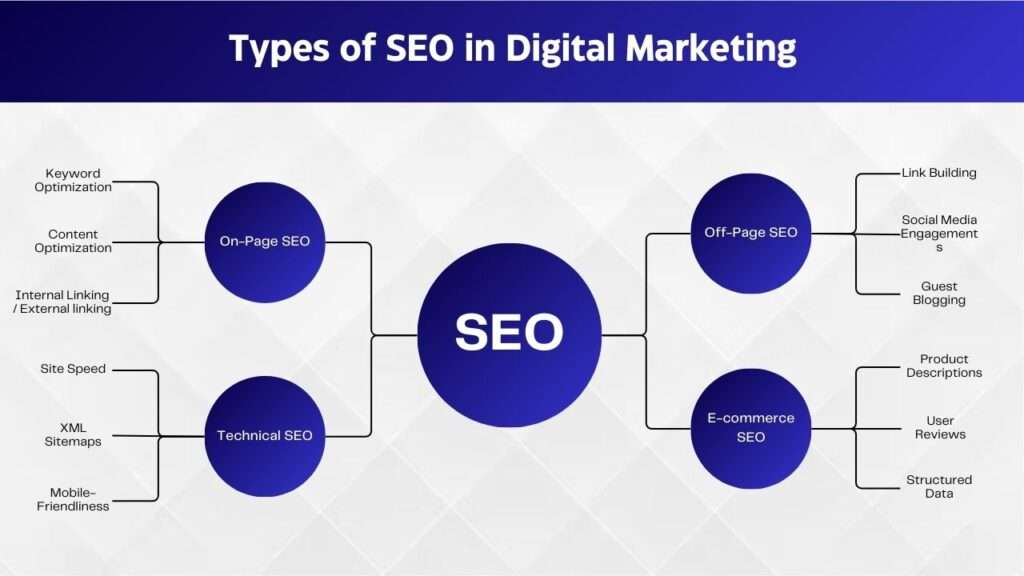Table of Content
In the evolving realm of digital marketing, search engine optimization (SEO) serves as a fundamental strategy for businesses looking to expand their visibility on the internet. As competition increases, understanding and taking advantage of SEO becomes paramount. This article highlights the complex role of SEO in digital marketing and explores its different types of SEO in detailed guide.
What is Digital Marketing?
Digital marketing includes all marketing efforts that use the Internet or electronic devices. Businesses take advantages of digital channels like search engines, social media, email, and websites to connect with current and potential customers. Digital marketing is a broad term that includes many strategies like content marketing, social media marketing, email marketing, and SEO.
Key Components of Digital Marketing:
- Content Marketing: It delivers valuable content to motivate the target audiences to continue visit their website or channel.
- Social Media Marketing: Use social media platforms to promote products or services.
- Email Marketing: It is a type of digital marketing method that uses to send emails to their specific audience to generate leads.
- Pay-Per-Click (PPC) Advertising: It is an online marketing model where company placed an advertisement on their website or channel to count user clicks or engagement.
What is SEO in Digital Marketing?
Search Engine Optimization (SEO) is the practice of optimizing a website to rank higher on search engine results pages (SERPs), thereby increasing the quantity and quality of organic traffic to the site. It involves various strategies, techniques, and tactics to make a website more appealing to search engines like Google, Bing, and Yahoo.
Core Elements of SEO:
- Keyword Research: It is a process of finding or analyzing search terms that potential customers use to search for products or services.
- On-Page SEO: Optimize web pages or blogs to rank higher and earn more relevant traffic to your website in search engines. This includes content optimization, HTML code improvements, and site architecture adjustments.
- Off-Page SEO: Activities outside the boundaries of the webpage, such as backlink building, social media marketing, and influencer outreach.
- Technical SEO: Enhancing the technical aspects of a website, such as improving page speed, mobile-friendliness, and ensuring proper indexing by search engines.
Role of SEO in Digital Marketing
SEO plays a pivotal role in digital marketing by ensuring that businesses are visible to their target audience through organic search results. Here’s how SEO contributes to a successful digital marketing strategy:
1. Improve Online Visibility:
SEO focuses on increasing the visibility of a website on different search engines like Google, Bing, Yahoo, etc. When a site ranks higher on SERPs, it attracts more clicks and traffic. This visibility is crucial for brand awareness and customer acquisition.
2. Building Credibility and Trust:
Higher-ranking websites are often considered more reliable and trustworthy. SEO in digital marketing helps establish a website’s authority through quality content, backlinks, and user-friendly experiences, which fosters trust among users.
3. Generate Targeted Traffic:
SEO targets specific keywords related to a business’s offerings. This means the traffic generated through SEO is highly relevant and more likely to convert, leading to better ROI compared to other marketing channels.
4. Supporting Content Marketing:
Quality content is a cornerstone of SEO in digital marketing. By aligning content marketing strategies with SEO practices, businesses can create informative, engaging, and optimized content that attracts and retains audiences.
5. Better User Experience:
SEO involves optimizing a website for better usability, speed, and mobile-friendliness. These factors contribute to an improved user experience, which can lead to higher engagement and conversions.
6. Cost-Effectiveness:
In the long term, SEO proves to be a more cost-effective strategy than paid advertising. While it requires an initial investment, the ongoing benefits of sustained organic traffic can provide a significant return on investment.
Gains of Using SEO in Digital Marketing
Implementing SEO in digital marketing offers several advantages:
1. Long-Term Results:
In contrast to PPC, which offers quick but temporary outcomes, SEO establishes a solid base for sustained long-term success. With consistent efforts, websites can maintain high rankings and continue attracting traffic over time.
2. Increased Brand Awareness:
As a website ranks higher for multiple keywords, it becomes more visible to a broader audience. This increased visibility leads to better brand recognition and recall.
3. Better Conversion Rates:
SEO in digital marketing focuses on reaching users who are actively looking for particular information, products, or services. These users are more likely to convert compared to those reached through other forms of advertising.
4. Competitive Edge:
By staying ahead of SEO trends and best practices, businesses can outperform competitors who are not investing in SEO in digital marketing, and gain a larger share of the market.
5. Data-Driven Insights:
SEO tools provide valuable data on user behavior, keyword performance, and competitor strategies. These insights help businesses refine their marketing strategies and make informed decisions.
Types of SEO in Digital Marketing
SEO is multifaceted, it includes different types that address different aspects of optimization. Here are the primary types of SEO in digital marketing:

1. On-Page SEO:
It Focuses on optimizing individual pages on a website to rank higher and earn more relevant traffic to website. Here are some key elements include:
- Title Tags and Meta Descriptions: Title should be engaging and short (around 50 to 60 characters) that contains your focus key phrase and descriptions that include target keywords.
- Header Tags (H1, H2, H3): Use Headings or Sub Headings to structure content and include relevant keywords.
- Keyword Optimization: Keyword is the important factor for SEO in digital marketing, so chose your keyword wisely and optimize accordingly.
- Internal Linking: It is a link from one page of your website that connect one page to another page.
- Image Optimization: Use proper alt text and proper file names to images in order to improve search visibility in image searches.
2. Off-Page SEO:
It Involves activities outside the website to improve its ranking or authority. Key strategies include:
- Link Building: Create quality links from reputable and high authority websites to boost your website authority and ranking.
- Social Media Engagement: Promoting content on social platforms by using graphics or videos to generate organic or referral traffic to your website and increase visibility.
- Guest Blogging: Writing articles for other sites to gain exposure and backlinks.
3. Technical SEO:
Technical SEO is Important part of SEO in digital marketing, It Focuses on the backend structure and performance of a website that includes:
- Site Speed: Make sure your website should be load fast around 1 sec to 3 sec.
- Mobile-Friendliness: Optimize your web page for mobile devices to cater to a larger audience.
- Secure Sockets Layer (SSL): Using HTTPS to secure user data and enhance trust.
- XML Sitemaps: Creating sitemaps to help search engines index the site effectively.
- Schema Markup: Generate Schema markup code from online tools and place to your website header or body of your page.
4. Local SEO:
Local SEO aimed at optimizing a website for local search results. Key practices include:
- Google My Business (GMB) Optimization: Creating and optimizing a GMB profile to appear in local searches.
- Local Citations: Make sure to put the business’s name, address, and phone number (NAP) to your website and social media platforms to help visitors to find you.
- Local Keywords: Targeting keywords with local intent, such as “near me” searches.
5. E-commerce SEO:
E-commerce SEO involves using relevant keywords that potential customers are likely to search for, it improve website’s visibility and attract targeted traffic from search engines. Key tactics include:
- Product Descriptions: Write unique and keyword-rich descriptions for each product.
- User Reviews: Encourage customer to give reviews about your product or services to build trust and provide fresh content.
- Structured Data: Using schema markup to enhance product listings in search results.
6. Voice Search SEO:
Optimizing content for voice search queries. Key strategies include:
- Conversational Keywords: Using natural language and long-tail keywords.
- FAQ Pages: Creating content that answers common questions directly.
Conclusion
SEO remains a vital component of a successful digital marketing strategy. By increasing online visibility, building credibility, generating targeted traffic, and supporting content marketing efforts, SEO in digital marketing provides many benefits that contribute to long-term growth. Understanding the different types of SEO in digital marketing and implementing best practices can help businesses stay ahead of the competition and achieve their marketing goals.







